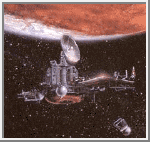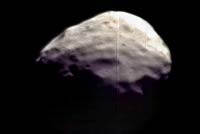
USSR Mars Lander/Orbiter
Courtesy of NASA's National Space Science Data Center
Mission Statistics:
Launch Date: July 7, 1988 (Phobos 1) and July 21, 1988 (Phobos 2)Launch Vehicle: Proton
Mass: 2,600 kilograms (5,720 pounds); 6,220 kilograms (13,685 pounds) with orbital insertion hardware attached
Power System: Solar panels
Description
Phobos 1, and its companion spacecraft Phobos 2, were the next-generation in the Venera-type planetary missions, succeeding those last used during the Vega 1 and 2 missions to comet P/Halley. The objectives of the Phobos missions were to:- conduct studies of the interplanetary environment;
- perform observations of the Sun;
- characterize the plasma environment in the Martian vicinity;
- conduct surface and atmospheric studies of Mars; and,
- study the surface composition of the Martian satellite Phobos.
Phobos 1 operated nominally until an expected communications session on 2 September 1988 failed to occur. The failure of controllers to regain contact with the spacecraft was traced to an error in the software uploaded on 29/30 August which had deactivated the attitude thrusters. This resulted in a loss of lock on the Sun, resulting in the spacecraft orienting the solar arrays away from the Sun, thus depleting the batteries.
Phobos 2 operated nominally throughout its cruise and Mars orbital insertion phases, gathering data on the Sun, interplanetary medium, Mars, and Phobos. Contact was lost shortly before the final phase of the mission, during which the spacecraft was to approach within 50 meters (110 feet) of Phobos' surface and release two landers, one a mobile 'hopper', the other a stationary platform. The mission ended when the spacecraft signal failed to be successfully reacquired on 27 March 1989. The cause of the failure was determined to be a malfunction of the on-board computer.
 Collection of Phobos II Color Imagery
Collection of Phobos II Color Imagery
This is a collection of all the color imagery taken by Phobos II containing
both Phobos and Mars, and Mars alone as shown in the upper right-hand corner.
The photos in the upper left, middle right, and lower right were processed
by he Russians at IKI followed by Ted Stryk to reduce the color enhancements
IKI made. The middle and lower left images, as well as the top right,
were processed Ted Stryk from black and white Phobos II images.
They have been corrected for distortion. The color composite was made
by combining the red, blue, and an artificially produced green image made
by averaging the red and blue channels. The red channel in the upper
left image was so badly overexposed that is was nearly a washout, so the
color data is extremely poor. Unknown at the time taken, the image
at the middle left, with the badly overexposed disk of mars, was to be the
last color image of the Russian planetary program, taken two days before
contact was lost forever with Phobos II.
(Courtesy Ted Stryk)
 Phobos 2 VSK image of the Martian Moon Phobos
Phobos 2 VSK image of the Martian Moon Phobos
This image was taken by the VSK instrument on the USSR Phobos 2 spacecraft in
March of 1989 shortly before the spacecraft failed.
It is made from blue and red images superimposed on a
broadband high resolution image. The color is as true as can be with no
real green image, although color variations are exagerated. From the VSK
data, this is perhaps the prettiest color picture.
(Courtesy Ted Stryk)

 Space History
Space History